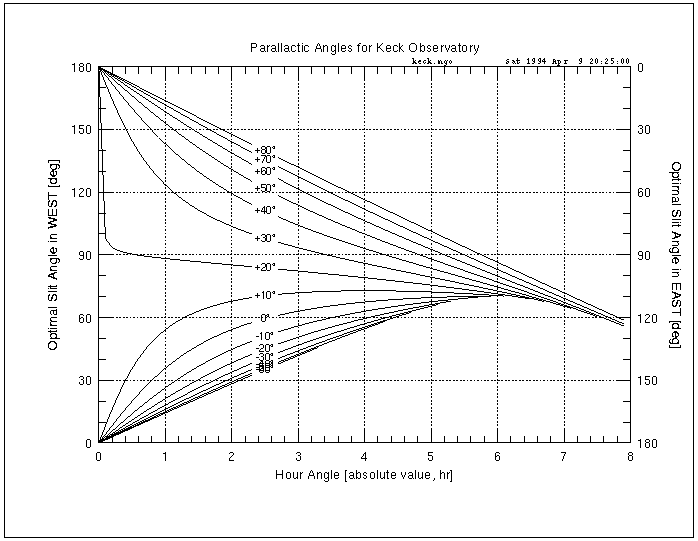Parallactic Angle Observations
Background
When acquiring spectra of an astronomical target at Keck, the observer generally has the freedom to select the on-sky position angle at which to orient the slit. Generally, the optimal position angle is the parallactic angle; i.e., the angle at which the slit is aligned with the direction from the target to the zenith. When observing targets which are away from the zenith, the light is dispersed in the vertical direction as a result of terrestrial atmospheric refraction. If the slit is not aligned vertically then certain wavelengths of light will fall outside the slit and thus the resulting spectrum will not capture all of the light from the object.Parallactic Observing with Keck
To observe at the parallactic angle, observers can generally ask their Observing Assistant to orient the slit for parallactic observing.- For long exposures on bright targets using on-slit guiding, the preferred mode is to place the instrument rotator into vertical angle mode at an orientation of 0°.
- For short exposures using offset guiding, have the OA select position angle mode and set the slit position angle to the current parallactic angle reported by SKY (old program for selecting and previewing targets since replaced by MAGIQ).
- For long exposures using offset guiding, have the OA select position angle mode and set the slit position angle to the parallactic angle for the midpoint of the observation. Again, this information can be obtained from SKY.
Parallactic Angles for Keck
The accompanying plot displays the parallactic angle as a function of the hour angle for Keck Observatory, for various declinations. Each curve on the plot applies to the listed declination.

To use the plot for observations east of the meridian, find the point at which the corresponding declination curve intersects the hour angle of the observation, then read the optimal slit angle (i.e., position angle) off the right side of the plot. For example, for a target at declination +40° observed at an hour angle of 2 hr east, the parallactic angle is 60°.
To use the plot for observations wast of the meridian, find the point at which the corresponding declination curve intersects the hour angle of the observation, then read the optimal slit angle (i.e., position angle) off the left side of the plot. For example, for a target at declination +40° observed at an hour angle of 2 hr west, the parallactic angle is 120°.
See Also
Send questions or comments to: